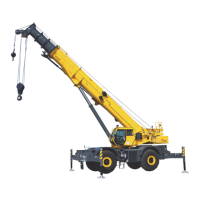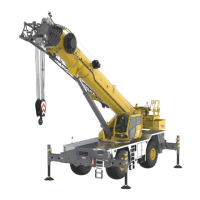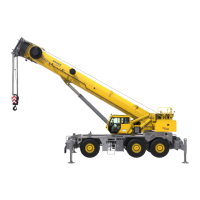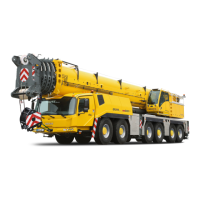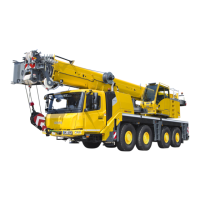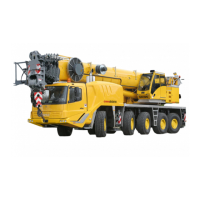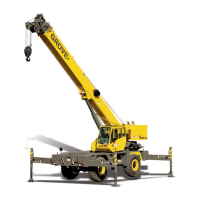BOOM GRT880 SERVICE MANUAL
4-2
Published 10/19/2017, Control # 618-00
THEORY OF OPERATION
Boom extension and retraction is accomplished with two
telescope cylinders, five extension cables, and two retraction
cables. The lower telescope cylinder rod is secured to the
rear of the boom base section and the barrel is secured to
tele 1 by a trunnion. The upper telescope cylinder rod is
secured to the rear of tele 1 and the barrel is secured to tele
2 by a trunnion. The extension cables are secured to the
back of tele 3, run around extension sheaves mounted to the
tip of the upper cylinder, and are secured on the opposite
end to the cable anchor at the tip of the lower cylinder.
The hydraulic fluid in both lower and upper telescope
cylinders is routed through the rods so that the barrels can
extend. A pressure transducer is used to switch from
extending the lower cylinder (tele 1) and the upper cylinder
(tele 2). The crane control system extends the lower cylinder
(tele 1) first. When the lower cylinder reaches its full stroke,
the pressure transducer senses the pressure increase. The
crane control system will then begin to extend the upper
cylinder (tele 2). As the upper telescope cylinder barrel
extends, the extend cables around the extend sheaves push
on the extend cables to pull tele 3 out at the same time tele 2
is extending.
A proximity sensor is used to switch from retracting the upper
cylinder (tele 2) and the lower cylinder (tele 1). The crane
control system retracts the upper cylinder first. When the
upper cylinder reaches full retraction, the proximity switch
mounted on the cable reel senses that tele 2 is fully
retracted. The crane control system will then begin to retract
the lower cylinder (tele 1). When the upper telescope
cylinder retracts tele 2, the two retract cables pull tele 3 in at
the same time.
BOOM REMOVAL
NOTE: The boom assembly must be rotated 180° (upside
down) before performing any assembly or
disassembly procedures.
.
NOTE: The boom may be disassembled with the base
section left on the crane if repair of the base section
is not necessary.
NOTE: Boom weighs approximately 10,660 kg (23,500 lb).
Removal of the swingaway boom extension will
simplify boom removal; therefore, the above weight
is for the boom without the swingaway boom
extension attached.
1. Extend and set outriggers to level the crane. Ensure
boom is fully retracted and in a horizontal position over
front of the crane.
2. If equipped, remove the swingaway boom extension
according to the removal procedures found in the
Operator Manual.
3. Remove hook block or headache ball and wind all wire
rope onto the hoist drum.
4. Elevate boom slightly to allow for withdrawal of the lift
cylinder rod end from the lift cylinder attach fitting on the
bottom of the boom.
5. Attach a lifting device to the boom that provides for equal
weight distribution.
6. Disconnect any electrical wiring from the boom.
7. Tag and disconnect hydraulic lines to the telescope
cylinder. Cap/plug all openings.
8. Block the lift cylinder.
9. Remove the capscrews, washers, and end plate
securing the upper lift cylinder shaft to the side of the
attachment fitting on the boom. Loosen the set screws
on opposite side.
10. Remove the upper lift cylinder shaft, spacers, and shims,
noting position of each.
11. Activate hydraulic system and retract the lift cylinder rod
enough to clear the attachment fitting. For removal of the
lift cylinder from the crane, refer to Lift Cylinder
Removal, page 4-58.
NOTE: Shut down crane before proceeding.
CAUTION
A rollover fixture with webbing is recommended to rotate
boom and tele sections. Chains are not recommended. If
a rollover fixture is not available, rotate tele sections using
adequate support with webbing.
A secure fixture that will prevent damage to the boom is
recommended to stabilize and hold the boom from moving
during removal of any section or sections.
CAUTION
Wear gloves when handling wire rope. Moderate to minor
injury may result if using bare hands.
DANGER
Ensure lifting device is capable of supporting the boom
assembly. Death or serious injury may result if the lifting
device cannot support the load.
DANGER
Ensure boom lift cylinder is properly supported before
disconnecting it from the boom. Death or serious injury
may result if lift cylinder is not supported.
Reference Only

